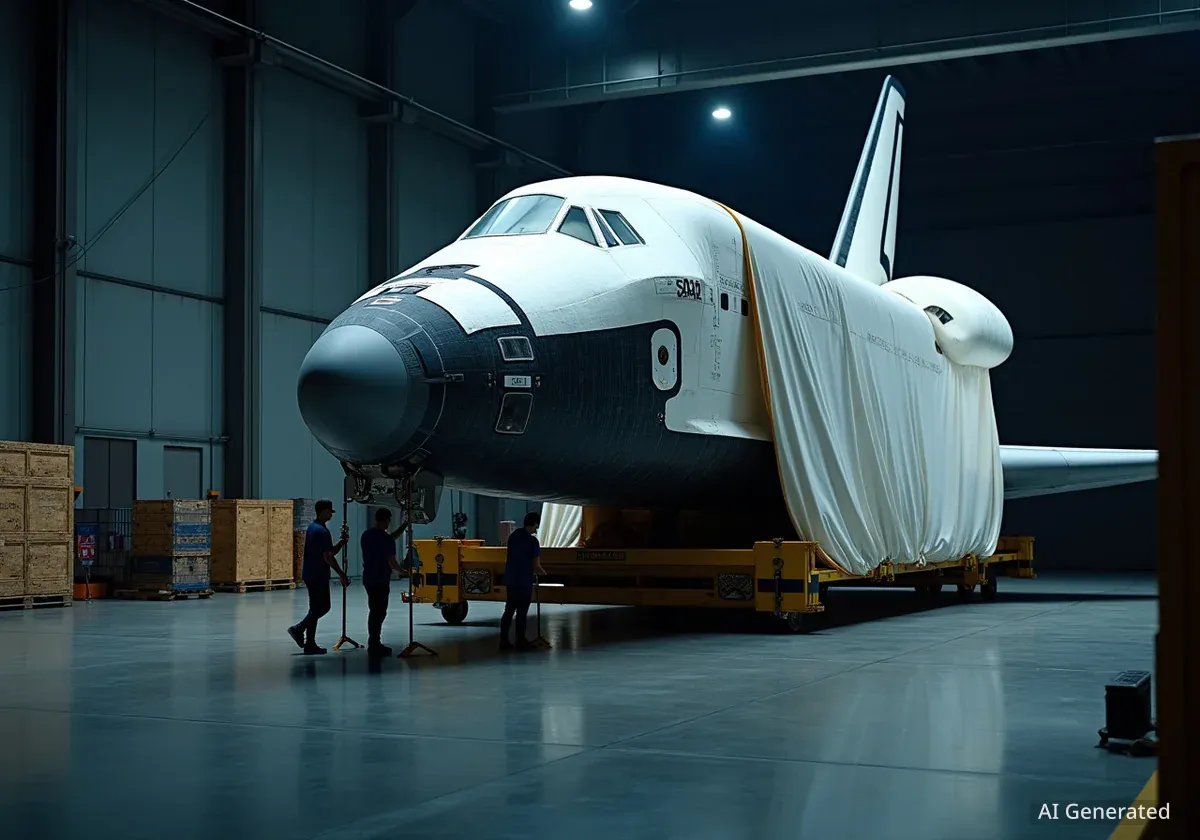Legislation signed into law in July 2025 has allocated $85 million to relocate the historic Space Shuttle Discovery from its current home at the Smithsonian's National Air and Space Museum in Virginia to Space Center Houston. The move, championed by Texas lawmakers, has sparked a debate over the cost, logistics, and preservation of the iconic spacecraft.
Key Takeaways
- A new law provides $85 million to move the Space Shuttle Discovery to Houston, Texas.
- The shuttle is currently displayed at the Smithsonian's Udvar-Hazy Center in Virginia.
- Texas Senators Ted Cruz and John Cornyn led the legislative effort, citing Houston's role as the home of Mission Control.
- The Smithsonian has expressed concerns about potential damage to the orbiter and estimates the actual moving cost at $300 to $400 million.
- The law sets a deadline of January 4, 2027, for the relocation to be completed.
New Legislation Funds Controversial Move
A provision included in the H.R. 1 budget reconciliation bill, enacted in July 2025, specifically designates funds for a "space vehicle transfer." This measure directs the relocation of the Space Shuttle Discovery from its long-term display in Virginia to a new facility in Texas.
The law allocates a total of $85 million for the project. According to the text, a minimum of $5 million is intended to cover the direct costs of transporting the orbiter, while the remaining $80 million is set aside for the construction of a new, climate-controlled building to house and display Discovery at Space Center Houston.
The legislation sets a firm deadline for the transfer. The move must be completed by January 4, 2027, creating a tight timeline for what experts describe as a highly complex and delicate operation.
The Four Remaining Space Shuttles
Following the retirement of the shuttle program, the surviving orbiters were distributed to museums across the country. Besides Discovery, the other shuttles on public display are:
- Atlantis: Located at the Kennedy Space Center Visitor Complex in Florida.
- Endeavour: Housed at the California Science Center in Los Angeles.
- Enterprise: The prototype orbiter, displayed at the Intrepid Sea, Air & Space Museum in New York City.
Discovery's Historic Legacy
Space Shuttle Discovery is the most flown orbiter in the fleet, with a remarkable service history that spanned from 1984 to 2011. Its contributions to science and space exploration are significant, cementing its status as a national treasure.
Discovery by the Numbers
- Total Missions: 39
- Time in Space: 365 days
- Distance Traveled: Nearly 150 million miles
- Orbits of Earth: 5,830
Key Missions and Achievements
Throughout its operational life, Discovery was responsible for numerous milestone missions. In 1990, it famously deployed the Hubble Space Telescope, an instrument that has since revolutionized our understanding of the cosmos.
The orbiter also played a critical role in the construction of the International Space Station (ISS). Discovery flew 13 missions to the station, delivering essential modules, supplies, and crew members that helped build and maintain the orbiting laboratory that has been continuously inhabited for over two decades.
The Political Push from Texas Lawmakers
The effort to bring Discovery to Texas was spearheaded by the state's Republican senators, Ted Cruz and John Cornyn. They first introduced the "Bring the Space Shuttle Home Act" in April 2025, arguing that Houston's central role in human spaceflight has not been properly recognized with an authentic orbiter.
Houston is home to NASA's Johnson Space Center, which includes the Christopher C. Kraft Jr. Mission Control Center. For the entirety of the Space Shuttle Program, every mission was managed from this facility.
"Houston has long been the cornerstone of our nation's human space exploration program," Senator Cornyn said in a statement. "I am glad to see this pass ... and look forward to welcoming Discovery to Houston and righting this egregious wrong."
Senator Cruz echoed this sentiment, stating that the move honors Houston's legacy as "the heart of America's human spaceflight program." He added that bringing the historic vehicle to the region would inspire future generations of scientists and engineers.
Smithsonian Cites Major Cost and Safety Concerns
While Texas officials celebrate the legislative victory, the Smithsonian Institution has raised serious objections. The organization, which manages the national collection of historic artifacts, is concerned about the risk of irreparable damage to the nearly 40-year-old spacecraft during a cross-country move.
Furthermore, the Smithsonian presented a cost estimate to Congress that starkly contrasts with the funding allocated in the bill. According to their analysis, the process of safely disassembling, transporting, and reassembling the orbiter would cost between $300 million and $400 million of taxpayer money, far exceeding the $85 million provided by the law.
The potential loss of Discovery from the national collection at the Udvar-Hazy Center is another point of contention. The Virginia facility was specifically designed to house large artifacts like the shuttle and is one of the world's most visited museums, providing access to millions of visitors each year.
Currently, Space Center Houston features a high-fidelity replica of a shuttle, named Independence, mounted atop the original Shuttle Carrier Aircraft, NASA 905. While a popular exhibit, proponents of the move argue that it cannot replace the historical significance of an actual, space-flown orbiter like Discovery.





